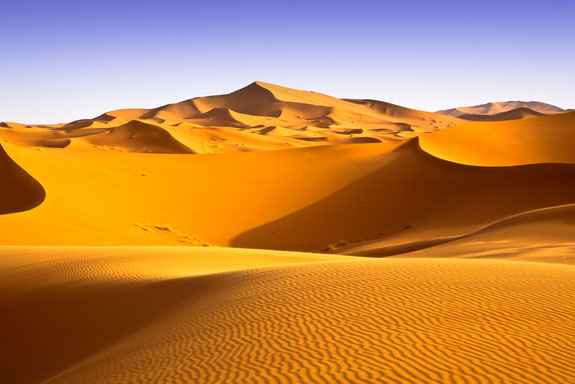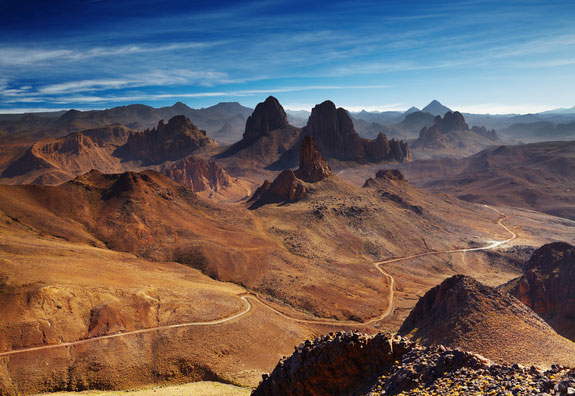The wild world on the Sahara desert
The image of the Sahara in many people's minds is a vast desert of sand dunes but in fact the terrain is quite diverse.
The Sahara is the largest and most extreme hot desert in the world. Only after two cold deserts of Arctic and Antarctica, the Sahara is the third largest desert in the world.

This is a picture of many people thinking about Sahara: one
sea dunes.In fact, the terrain here is quite diverse.
With an area of 9.4 million square kilometers, Sahara, Arabic means 'Large Desert' , covers most of North Africa, covering large areas of Algeria, Chad, Egypt, Libya, Mali, Mauritania, Morocco. , Niger, Northern Sahara, Sudan and Tunisia.
The Sahara is surrounded by the Atlantic Ocean on the western edge, Atlas Mountain and the Mediterranean Sea in the north, the Red Sea in the west, Sudan and the Niger River valley in the south.
The desert is divided into the western Sahara, the center of the Hoggar mountain range (Ahaggar), the Tibesti mountain range, the Air Mountains, a desert and plateau mountains, the desert of Ténéré and the Libyan desert, the driest region.
In the north, the Sahara reaches the Mediterranean Sea in Egypt and parts of Libya. In Cyrenaica and Maghreb, the Sahara is more influenced by the Mediterranean climate than the winter rainy season.

Hoggar Mountains in Algeria are located in the heart of the Sahara
Major cities located in the Sahara include Cairo (Egypt), Tripoli (Libya), Nouahchott, Mauritania's capital, Tamanrasset, Ouargla, Bechar, Hassi Messaoud, Ghardaia and El Oued in Algeria, Timbuktu in Mali, Agadez in Niger and Faya-Largeau in Chad.
The climate and topography of the Sahara
The northeast wind in the Sahara can blow as strong as a tornado and often causes a wave of sandstorms. Half of the Sahara has less than an inch of rainfall each year and the other half receives about 4 inches (10cm) of rain each year. Sudden rains are often showers.
The image of the Sahara in the minds of many is a desert of sand dunes and sand dunes, some of which stretch up to 180 meters. However, most of the Sahara is a rocky desert, a type of desert landscape consisting of very little sand and created by arid, harsh rocky plateaus.
Except for the Nile River, the Sahara's rivers and flows are irregular and seasonal. The Nile River flows through the deserts that originate in central Africa and into the Mediterranean.
The central part of the Sahara is very rare. North and south of the desert, along with plateaus with sparse lawns and desert bushes.
Animals in Sahara
Thousands of years ago, the Sahara had enough water for humans and animals to survive on the desert edge. There is evidence that this desert was once home to water animals such as crocodiles. Dinosaur fossils, including Afrovenator, Jobaria and Ouranosaurus have also been discovered here.
Prehistoric stone drawings have also described species that once lived in the Sahara once as well as cattle, giraffes, elephants and lions.
Today, there is very little water and vegetation to sustain life in most Sahara. Some exceptions are the Nile Valley, several northern oases and plateaus, where Mediterranean plants such as olive trees are discovered.
The change took place around 1600 BC after the Earth's displacement caused the temperature to warm up and reduce rainfall.
Camels, animals commonly associated with the Sahara symbol, appear in the desert around 200 AD. Compared to the horses they replaced, the advantage of camels is that their legs are soft so that they can move quickly, easily through sand and the ability to survive for 17 days without food and water.
Rodents, snakes and scorpions thrive in desert environments. The Sahara is home to the death scorpion species that can reach nearly 4 inches. Their venom contains large amounts of agitoxin and scyllatoxin.
Among the 40 more discovered rodents in the Sahara are gerbils, mice and squirrels. To avoid heat, the mouse jumps to dig holes beneath the desert sand to the wetter soil.

Addax nasomaculatus, or twisted horn antelope
is the largest native mammal in the Sahara.
Addax nasomaculatus, or kangaroo antelope, is the largest native mammal in the Sahara. This animal moves into small colonies throughout the Western Sahara, Mautitania and Chad.
Instead of drinking water, it filters moisture from grasses and desert bushes. Excessive hooves help this animal to cleverly move on the loose sand of the desert.
Wild dogs and many types of hyenas are among the Sahara carnivores. With a weight of less than 1.4kg, the desert fox is another carnivorous species that lives in the dunes of the day sand dunes and hunts at night.
Reference: Livescience
- Sahara wildlife is getting less and less
- Little known facts about the Sahara desert
- Found the true age of the Sahara desert?
- Many deserts ... water
- Could it be that humans have turned the Sahara into a desert?
- What is going on with the Sahara?
- Li explained the white snow phenomenon in the Sahara desert
- Found rare sahara newspaper
- The secret of living ants is free in the Sahara desert
- Snow fell for the first time in 37 years in the Sahara
- The arid Sahara desert used to be the place where the largest marine creatures lived
- The Sahara is submerged under a meter of snow
 'Fine laughs' - Scary and painful torture in ancient times
'Fine laughs' - Scary and painful torture in ancient times The sequence of numbers 142857 of the Egyptian pyramids is known as the strangest number in the world - Why?
The sequence of numbers 142857 of the Egyptian pyramids is known as the strangest number in the world - Why? History of the iron
History of the iron What is alum?
What is alum?